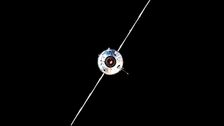Image credit: JWST/MIRI/Judy Schmidt
ABSTRACT breaks down mind-bending scientific research, future tech, new discoveries, and major breakthroughs.
In the eight months since the James Webb Space Telescope launched on its mission to explore the earliest formations of our universe, it’s sent back mind-blowing photographs of mysterious structures, ancient galaxies and dying stars. The JWST has 100 times the observational power of Hubble, and sometimes the images it captures outpace even our own understanding of space.
Advertisement
In a photograph of the star WR140, as pointed out by citizen scientist Judy Schmidt who reposted the image from the automated @JWSTPhotoBot on Twitter, a spiral of rings and rays fan out from the star’s bright white center. The rings aren’t perfectly circular, but look more like rounded squares, and not even astronomers seem to know what to do with it.
“I think it’s just nature doing something that is simple, but when we look at it from only one viewpoint it seems impossible, at first, to understand that it is a natural phenomenon,” Schmidt told Space.com, which reported on the bizarre image. “Why is it shaped the way it is? Why is it so regular?”
The feature is “bonkers,” according to Mark McCaughrean, an interdisciplinary scientist in the James Webb Space Telescope Science Working Group.
“The six-pointed blue structure is an artefact due to optical diffraction from the bright star WR140 in this #JWST MIRI image,” McCaughrean wrote on Twitter. “But red curvy-yet-boxy stuff is real, a series of shells around WR140. Actually in space. Around a star.”
Ryan Lau, an assistant astronomer at the National Science Foundation’s NOIRLab who led the program that gathered raw data on this and other JWST images, replied that “those nested ‘squircular’ rings are real,” and added that he and his colleagues have a paper coming on the subject that might shed more light on the rings’ odd shape.
The puzzling shape of the rings aside, their existence isn’t much of a mystery. WR140 is actually a pair of stars: a Wolf–Rayet star, which is an old, rapidly depleting star, and an O-type star, which are massive and bright but short-lived. As the pair of stars orbit, they produce cosmic dust when they come close to one another every 7.94 years, which is kicked out into space as the rings visible in this image with the JWST’s infrared capabilities.
This is only the latest in the many discoveries the JWST has in store for us; while this one probably isn’t aliens, maybe the next one will be.
Sign up for Motherboard’s daily newsletter for a regular dose of our original reporting, plus behind-the-scenes content about our biggest stories.
Related posts:
Views: 0
 RSS Feed
RSS Feed

















 September 3rd, 2022
September 3rd, 2022  Awake Goy
Awake Goy 





 Posted in
Posted in  Tags:
Tags: 
















